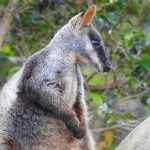BRUSH-TAILED ROCK-WALLABY
Imagine a creature with a sleek, soft fur coat, blending shades of grey and brown, allowing it to camouflage perfectly against the rocky landscapes. The Brush-tailed Rock-wallaby stands out with its distinctive long, bushy tail, which it uses for balance as it navigates the steep and craggy terrain. Its large, expressive eyes and pointed ears give it an alert and curious look, always on the watch for predators or a tasty morsel.
These wallabies are true masters of their rocky domain, found across fragmented populations in Queensland, New South Wales, and Victoria. They prefer habitats with plenty of crevices and ledges, where they can hide from predators and bask in the sun. These environments provide both shelter and a strategic vantage point to spot danger. One fascinating aspect of the Brush-tailed Rock-wallaby is its incredible agility. They can make remarkable leaps, sometimes over two metres high, from rock to rock, which is essential for navigating their precarious environment. Additionally, their tails are not just for show; they provide balance and support, acting almost like a fifth limb.
As herbivores, Brush-tailed Rock-wallabies have a varied diet that includes grasses, leaves, and fruits. They are particularly fond of native grasses and shrubs, which they nibble on during the cooler parts of the day, often venturing out at dusk and dawn to feed.
The breeding season for these wallabies can be quite flexible, often depending on environmental conditions. Typically, a female will give birth to a single joey after a gestation period of about 30 days. The tiny joey then continues to develop in its mother’s pouch for several months before emerging to explore the world, while still returning to the pouch for nourishment and safety.
While generally quiet, these wallabies can make soft clucking sounds, particularly between mothers and their young. These gentle vocalisations help maintain the bond and ensure the joey stays close.
Brush-tailed Rock-wallabies can live for around 10 to 15 years, though this can vary depending on environmental pressures and predation.
Sadly, the Brush-tailed Rock-wallaby is listed as vulnerable, with populations declining due to habitat destruction, predation by introduced species like foxes, feral dogs and cats, as well as competition for food with livestock. Conservation efforts are underway, focusing on habitat protection and predator control to give these remarkable creatures a fighting chance.
In the grand tapestry of Australia’s wildlife, the Brush-tailed Rock-wallaby stands as a testament to the wonders of adaptation and survival. Through understanding and conservation, we can ensure that future generations will also have the opportunity to marvel at these extraordinary creatures as they continue to leap across the rocky landscapes of eastern Australia.














